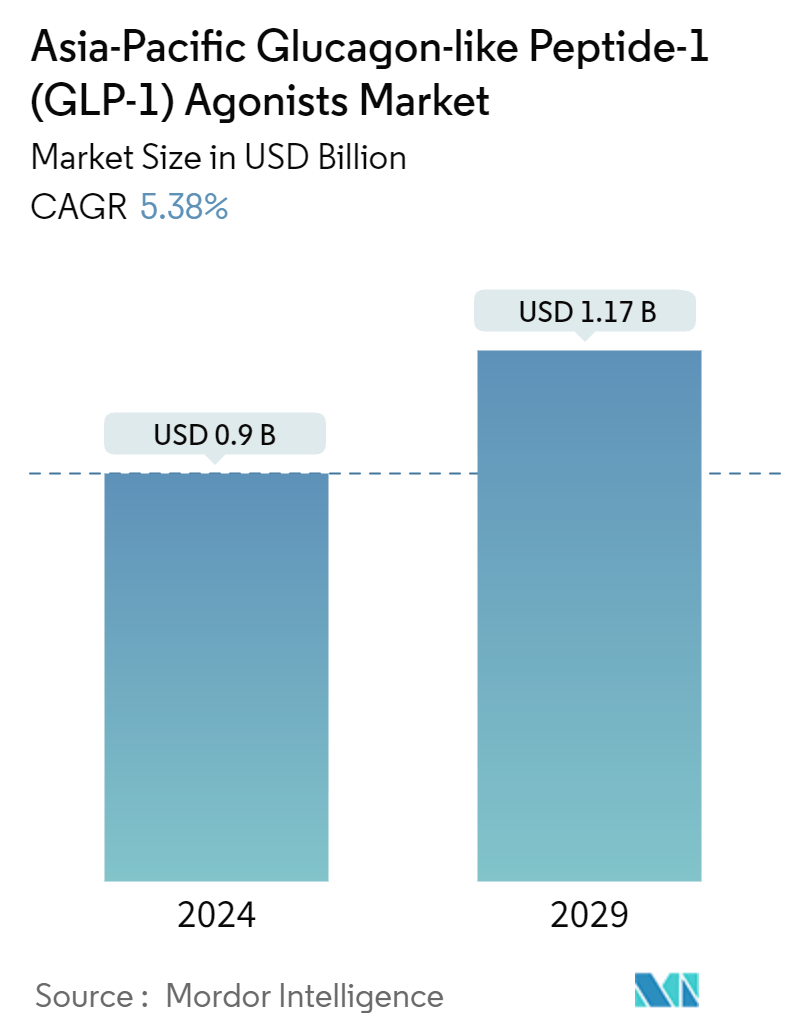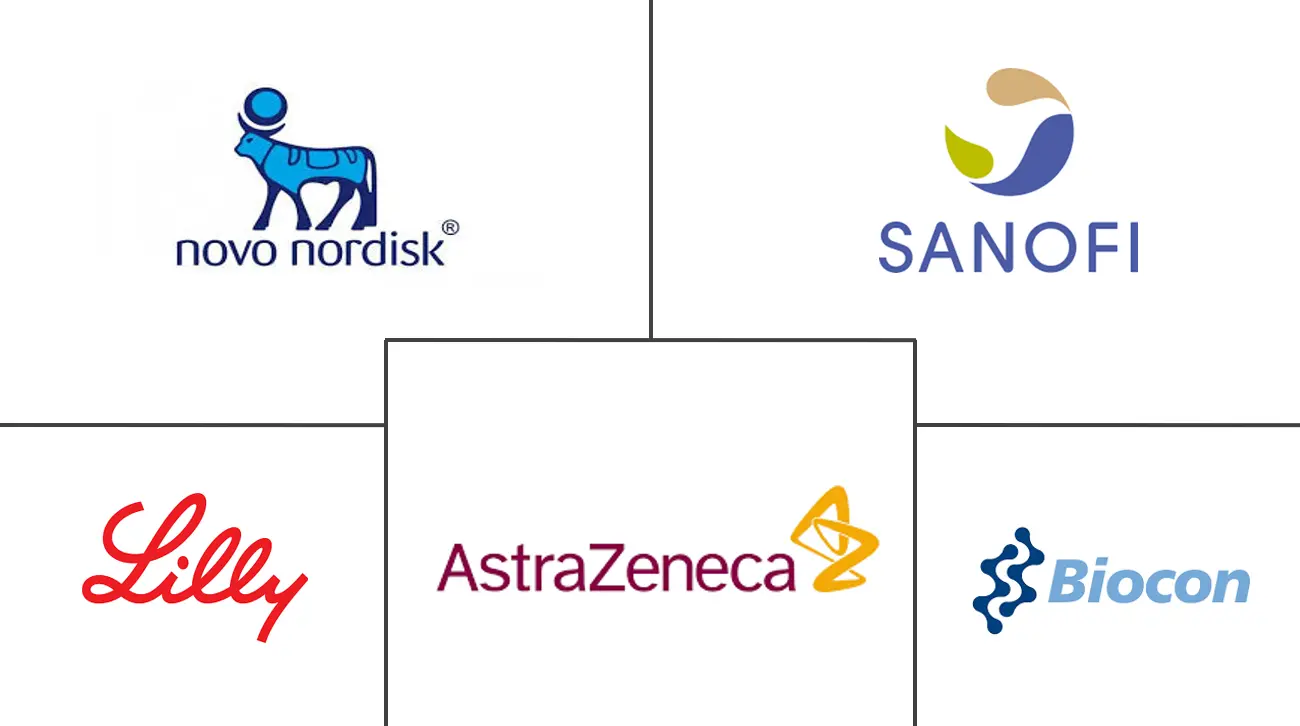Market Size of Asia-Pacific Glucagon-like Peptide-1 (GLP-1) Agonists Industry

| Study Period | 2018 - 2029 |
| Base Year For Estimation | 2023 |
| Market Size (2024) | USD 0.9 Billion |
| Market Size (2029) | USD 1.17 Billion |
| CAGR (2024 - 2029) | 5.38 % |
| Market Concentration | High |
Major Players
*Disclaimer: Major Players sorted in no particular order |
Asia-Pacific Glucagon-like Peptide-1 (GLP-1) Agonists Market Analysis
The Asia-Pacific Glucagon-like Peptide-1 Agonists Market size is estimated at USD 0.9 billion in 2024, and is expected to reach USD 1.17 billion by 2029, growing at a CAGR of 5.38% during the forecast period (2024-2029).
The COVID-19 pandemic positively impacted the Asia-Pacific Glucagon-like Peptide-1 (GLP-1) Agonists Market. Diabetes and uncontrolled hyperglycemia are risk factors for poor outcomes in patients with COVID-19 including an increased risk of severe illness or death. People with diabetes have a weaker immune system, the COVID-19 complication aggravates the condition, and the immune system gets weaker very fast. People with diabetes have more chances to get into serious complications rather than normal people.
Glucagon-like peptide-1 receptor agonists (GLP-1RAs) are a class of medications used for the treatment of type 2 diabetes and some drugs are also approved for obesity. One of the benefits of this class of drugs over sulfonylureas or meglitinides is that they have a lower risk of causing hypoglycemia. Besides being important glucose-lowering agents, GLP-1RAs have significant anti-inflammatory and pulmonary protective effects and an advantageous impact on gut microbes' composition. Therefore, GLP-1RAs have been potential candidates for treating patients affected by COVID-19 infection, with or even without type 2 diabetes, as well as excellent antidiabetic (glucose-lowering) agents during COVID-19 pandemic times.
According to International Diabetes Federation (IDF), 90 million adults (20-79) are living with diabetes in the IDF South-East Asia (SEA) Region. This figure is estimated to increase to 152 million by 2045 and 206 million adults (20-79) are living with diabetes in the IDF Western Pacific Region, which is estimated to increase to 260 million by 2045.
Diabetes mellitus has been of wide concern with its high prevalence, resulting in increased financial burdens for clinical systems, individuals, and governments. The market players are adopting various strategies such as collaborations, partnerships, mergers, acquisitions, and expansions to increase market share. Technological advancements have increased over the period leading to several modifications either in the Glucagon-like peptide-1 receptor agonists drugs or the formulations being developed.
Therefore, due to increased prevalence and the aforementioned factors, the studied market is anticipated to witness growth over the analysis period.
Asia-Pacific Glucagon-like Peptide-1 (GLP-1) Agonists Industry Segmentation
GLP-1 receptor agonists are a type of non-insulin medication that is used in combination with diet and exercise to help treat type 2 diabetes. The Asia-Pacific glucagon-like peptide-1 (GLP-1) agonists market is segmented by drugs, brands, and geography . The report offers the value (in USD) and volume (in units) for the above segments.
| Drug | ||||
| ||||
| ||||
| ||||
| ||||
|
| Geography | |
| Japan | |
| China | |
| Australia | |
| India | |
| South Korea | |
| Malaysia | |
| Indonesia | |
| Thailand | |
| Philippines | |
| Vietnam | |
| Rest of Asia-Pacific |
Asia-Pacific Glucagon-like Peptide-1 (GLP-1) Agonists Market Size Summary
The Asia-Pacific glucagon-like peptide-1 (GLP-1) agonists market is poised for significant growth, driven by the increasing prevalence of diabetes and obesity in the region. This market is characterized by the use of GLP-1 receptor agonists, which are effective in managing type 2 diabetes and are also approved for obesity treatment. These medications offer advantages over traditional treatments, such as a lower risk of hypoglycemia and additional benefits like anti-inflammatory and pulmonary protective effects. The COVID-19 pandemic has further highlighted the importance of these drugs, as individuals with diabetes are at a higher risk of severe complications from the virus. The market is witnessing a surge in demand due to the rising incidence of diabetes, particularly in countries like China and India, where lifestyle changes and urbanization have contributed to the epidemic.
Key players in the Asia-Pacific GLP-1 agonists market, including Eli Lilly, Sanofi, Novo Nordisk, and AstraZeneca, are actively expanding their presence through strategic collaborations and technological advancements. The market is also benefiting from regulatory approvals and the introduction of new formulations, such as oral semaglutide, which enhance treatment options for patients. The growing awareness of diabetes management and the need for effective treatments are driving market growth, as evidenced by initiatives in countries like China aimed at improving diabetes detection and management. As the region continues to grapple with the challenges posed by diabetes, the GLP-1 agonists market is expected to expand, offering promising opportunities for manufacturers and healthcare providers alike.
Asia-Pacific Glucagon-like Peptide-1 (GLP-1) Agonists Market Size - Table of Contents
-
1. MARKET DYNAMICS
-
1.1 Market Overview
-
1.2 Market Drivers
-
1.3 Market Restraints
-
1.4 Porter's Five Forces Analysis
-
1.4.1 Bargaining Power of Suppliers
-
1.4.2 Bargaining Power of Consumers
-
1.4.3 Threat of New Entrants
-
1.4.4 Threat of Substitute Products and Services
-
1.4.5 Intensity of Competitive Rivalry
-
-
-
2. MARKET SEGMENTATION
-
2.1 Drug
-
2.1.1 Exenatide
-
2.1.1.1 Byetta
-
2.1.1.2 Bydureon
-
-
2.1.2 Liraglutide
-
2.1.2.1 Victoza
-
-
2.1.3 Lixisenatide
-
2.1.3.1 Lyxumia
-
-
2.1.4 Dulaglutide
-
2.1.4.1 Trulicity
-
-
2.1.5 Semaglutide
-
2.1.5.1 Ozempic
-
-
-
2.2 Geography
-
2.2.1 Japan
-
2.2.2 China
-
2.2.3 Australia
-
2.2.4 India
-
2.2.5 South Korea
-
2.2.6 Malaysia
-
2.2.7 Indonesia
-
2.2.8 Thailand
-
2.2.9 Philippines
-
2.2.10 Vietnam
-
2.2.11 Rest of Asia-Pacific
-
-
Asia-Pacific Glucagon-like Peptide-1 (GLP-1) Agonists Market Size FAQs
How big is the Asia-Pacific Glucagon-like Peptide-1 Agonists Market?
The Asia-Pacific Glucagon-like Peptide-1 Agonists Market size is expected to reach USD 0.9 billion in 2024 and grow at a CAGR of 5.38% to reach USD 1.17 billion by 2029.
What is the current Asia-Pacific Glucagon-like Peptide-1 Agonists Market size?
In 2024, the Asia-Pacific Glucagon-like Peptide-1 Agonists Market size is expected to reach USD 0.9 billion.

